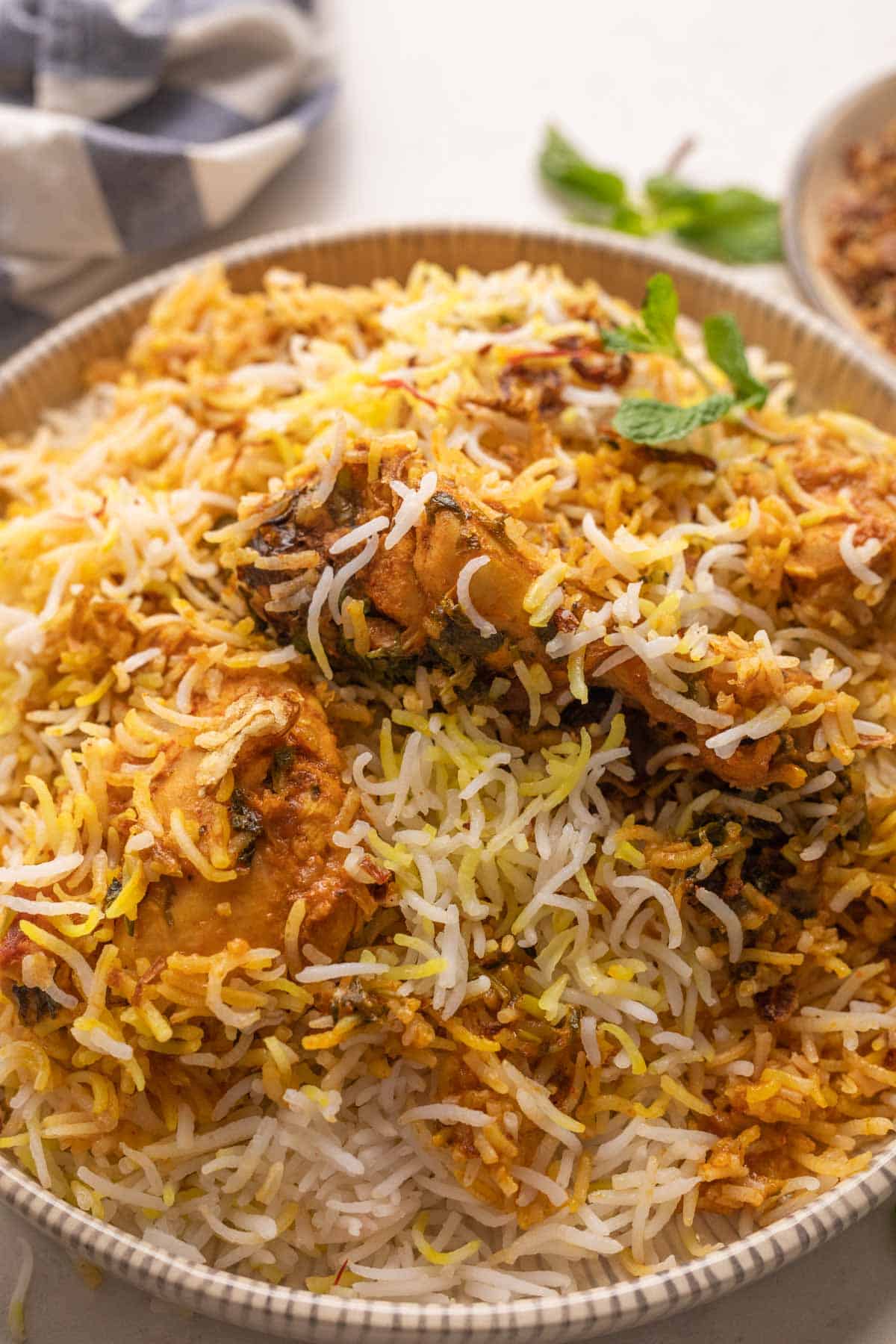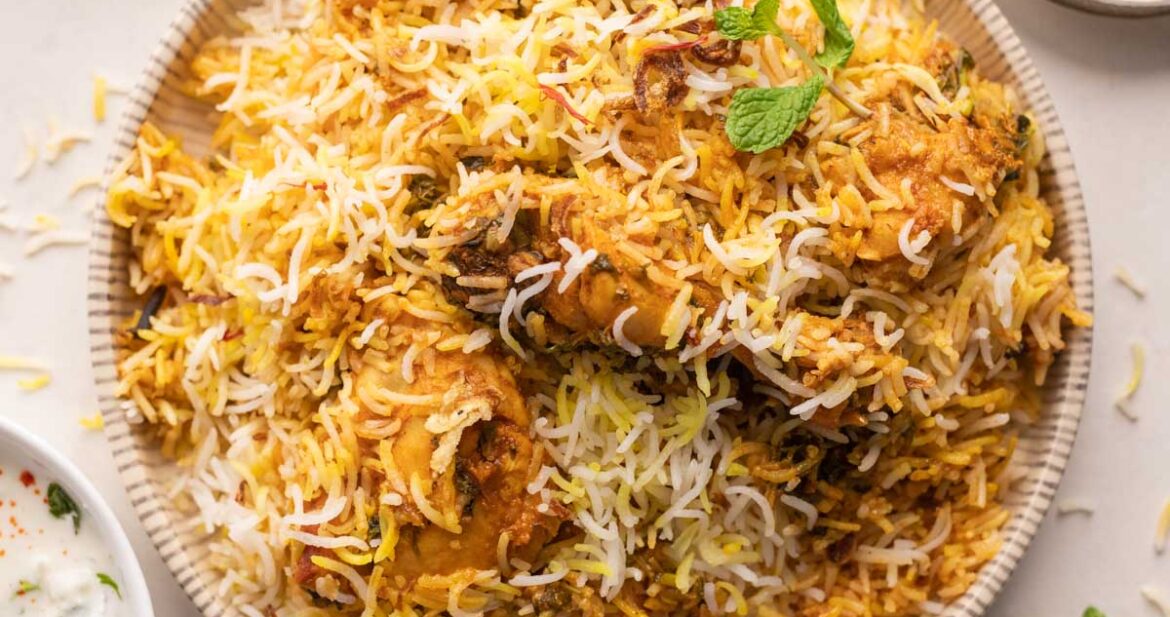Love Biryani? Me too! I’ve put together 19 Tips to make the Best Biryani possible. Let's up our biryani game and never fail at it again!

I have 5 amazing biryani recipes on the blog - the most popular Chicken Biryani, Mutton Biryani, Chicken Donne Biryani, Paneer Makhani Biryani and Vegetable Biryani
And I’m thinking of new biryani recipes every day because biryani is love! And India has so many varieties of biryani, each different in flavor and texture and still as good as the other.
However, it can be a little difficult if you don’t get the basics right, which is where I come in - with some basic tips to make the best biryani, and always get it right. Your house will smell amazing, your tummies will be full and your hearts will be happy.
What is Biryani?
Biryani comes from Iran and is a method of cooking meat and rice together by layering and cooking it with ghee, whole spices, herbs and saffron. It's a delicious meal of its own that Indians have truly made their own. In various parts of the world, its also known as biriani, beryani or beriani.
The Basics Of Cooking Biryani
- Use the best ingredients: This goes without saying - a dish will only be as good as the ingredients you use. Biryani requires high-quality ingredients such as aged basmati rice, ghee, curd, saffron, powdered and whole spices, vegetables or meat etc. For example, using fresh ginger and garlic paste instead of store bought plays a huge role in the final flavor of the dish!
- Fried Onions are key: Most biryanis list fried onions or birista as an ingredient. Onions are generally sliced and then fried on low till they become crisp and golden brown. These are then used in various stages - to marinate and flavor the meat, in the gravy masala and to layer the biryani. They add that distinct flavor, umami and richness. You can make birista at home or use store bought fried onions which are easily available. I for one mostly use store bought - a shortcut that makes no difference to the final biryani!
- Fat is flavor: A key aspect where you do not compromise in biryani is the fat. Whatever fat you use, be it a neutral or flavored oil, remember to be gracious with it. It not only keeps the rice moist, but it helps coat the rice grains keeping them separate and preventing them from becoming mushy. Our choice of fat is always ghee.
Watch How to Make Chicken Biryani
Rice
- Buy the right rice: In the case of biryani, the rice most commonly used is aged Basmati rice. It is a variety of long-grain rice and is known for its fragrance. Always buy from a trusted brand or check the rice’s quality, fragrance and feel before buying.
- Soak the rice: Basmati rice is a long-grain rice that needs to be soaked. Soaking removes the excess starch and softens the hard shell making it easier and faster to cook. But remember not to soak it for longer than 30 minutes. As this will cause the rice to overcook and make it mushy while cooking.
- Salt is key: Salting every element is important. While cooking the rice in water, it should be well salted to the extent that it tastes like seawater. We generally use 2 tablespoons Salt for 2 cups Rice which is cooked in 6 cups of Water.
- Whole spices add flavor: The rice is cooked in water that has whole spices simmering in it. The whole spices add flavor and aroma to the rice itself
- Use Precise cooking times: Rice is almost always cooked up to 70% doneness. The water is then drained and the rice is layered along with biryani masala, meat, vegetables and other ingredients. Once layered, the biryani is cooked for about 20 minutes on low heat which helps the rice to cook fully and for the flavors to meld. Hence, it is super important that the rice is not fully cooked before layering. This will also prevent it from becoming sticky and mushy. When making a biryani, remember precise cook times are important.
- Always cook the rice fresh: Unlike all the other components that can be prepped the previous day, always cook the rice for the biryani just before layering it. The rice should be hot when its layered with the meat or vegetables so that the steam from the rice helps in the cooking process.
The Masala
- Marinate to inject flavor: Marinating is the first step to any biryani, especially if you make a non-vegetarian version. Marinating the meat not only enhances flavor but also locks in the moisture and tenderizes the meat. Biryanis also have a long cooking time. Marinating it beforehand will prevent the meat from drying out and becoming tough.
- Curd is a good meat tenderiser. Including curd in the marinade will allow the protein in the meat to react with acids and absorb more moisture.
- Rice to meat ratio: Generally 1:1 rice to meat ratio so that you are never without enough meat or rice. Some people also prefer 2 parts meat to 1 part rice but personally, I find that a bit too much. Biryani is about balance as much as it is about plenty.
- Make the gravy or masala ahead and store it. This is especially true for a non vegetarian version like chicken biryani or mutton biryani where the gravy in which the meat is cooked can be made the previous day and refrigerated. So that on the day, all you have to do is cook the rice, layer and dum. Note: Always bring the gravy to a simmer before layering and do not add it cold.
Layering
- Herbs are key: Fresh mint and coriander are always used while layering the biryani. The herbs help cut through the richness and help bring everything together
- Don’t skimp on ghee while layering. The fat adds flavor and aroma and keeps the biryani moist
- Components can be made ahead: As is common in most restaurant dishes, a lot of the components are made ahead. In this case, the masala gravy for the biryani can be made ahead and refrigerated. The same goes for the fried onions as well. Cook the elements separately, transfer them into airtight containers and refrigerate for up to 2 days. If you want to make it much more in advance, you can freeze it. However, make the rice just before layering and dum because it needs to be hot when it's layered. You should also warm the masala gravy before layering and bring it to a simmer.

Cooking
- Choose the right pot: Remember to use a flat heavy-bottomed pot to make the biryani. As it is a slow-cooked dish, the bottom part of the pot is exposed to constant heat. If you use a low-quality thin pot, the biryani will not cook evenly and the bottom will burn. To avoid the biryani from burning, you can even place a tawa under the pot while cooking. This will ensure that the heat is more evenly distributed and is not direct to the pot.
- Cook on low: Biryani is a slow-cooked dish. The reason for this is to allow the flavors and aromas to blend and combine once the dish is layered.
- Cook on dum: This method requires you to seal the pot using a wet cloth, aluminum foil or even using some atta (whole wheat flour plus water dough - like chapati dough). This will ensure that no steam escapes the pot, resulting in a more fragrant and moist dish.


Veeraf Vaghaiwalla says
Great recipe, will try itvout.
Anika Shree says
Your blog has become my go-to resource for new recipe ideas. I've tried several of your dishes and they've all turned out fantastic. Thank you for inspiring me in the kitchen!
Richa says
So glad to hear that Anika!
Anika Shree says
I love how your food blog celebrates the beauty and joy of cooking. Your passion for creating delicious dishes shines through in every post. The detailed instructions and personal anecdotes make me feel like we're cooking together in the kitchen. Can't wait to try out more of your recipes!
Summaya says
tks for the tips for making biryani
John Arnold says
Wow! This is really special. Learned many things.